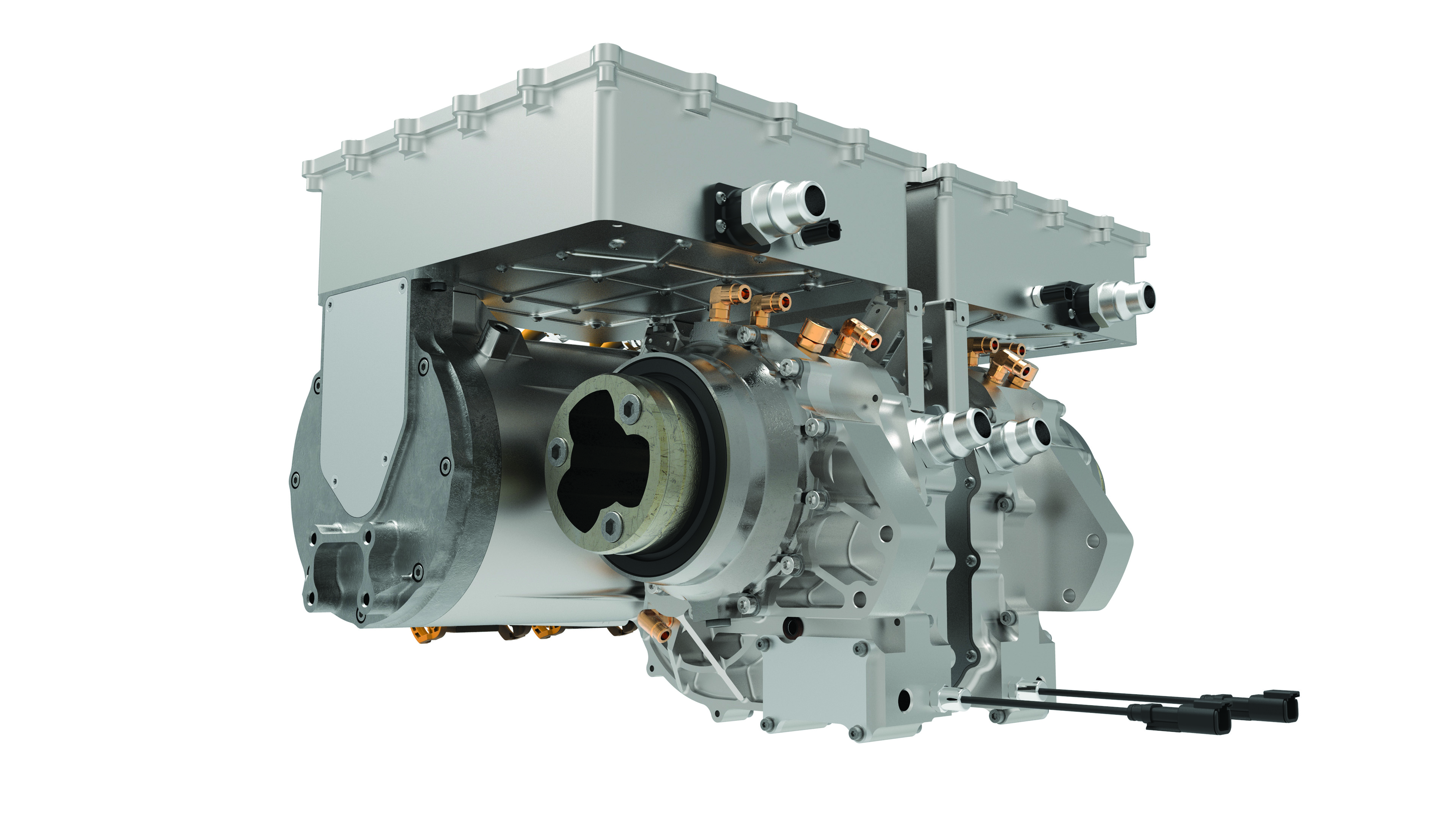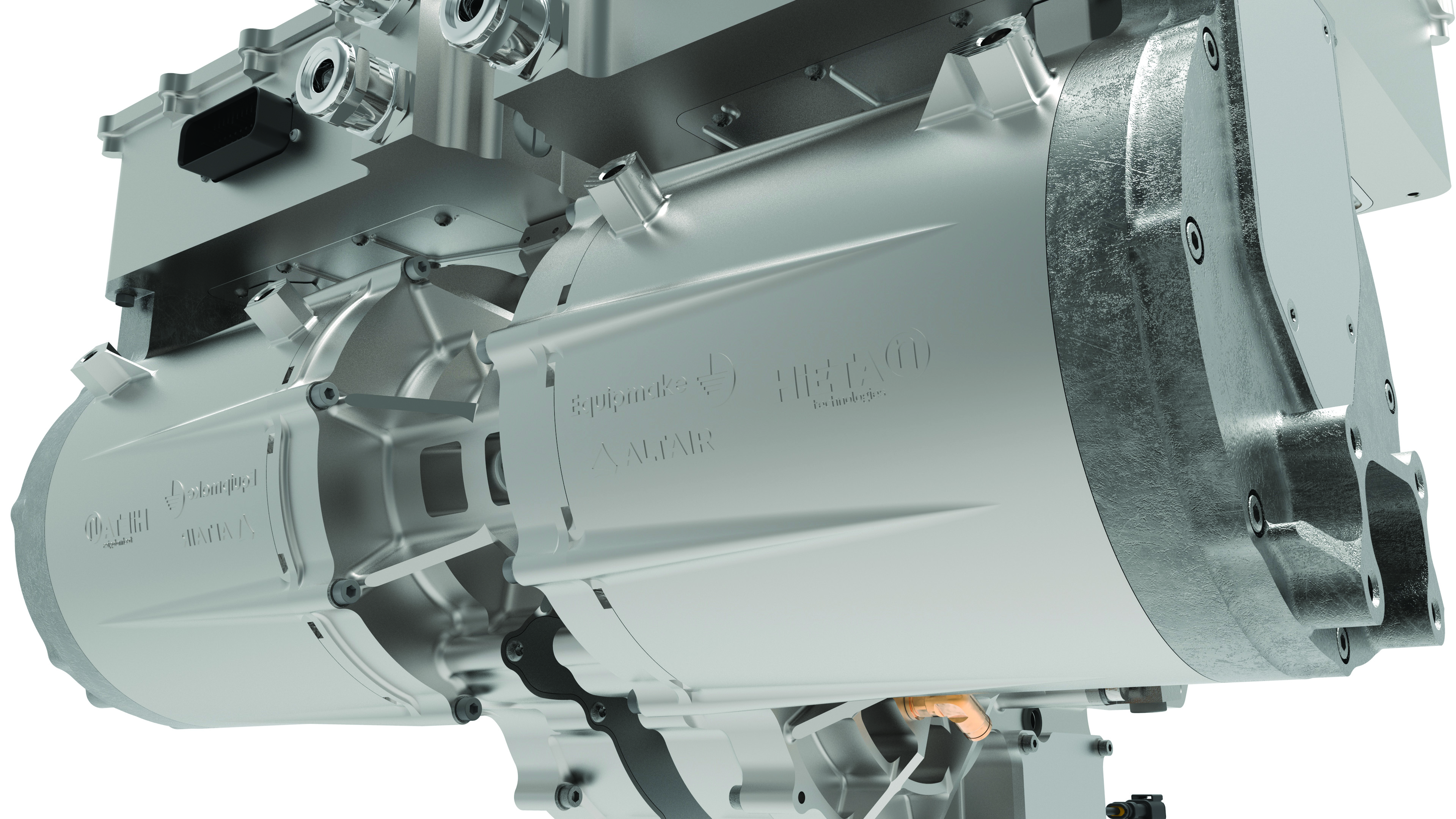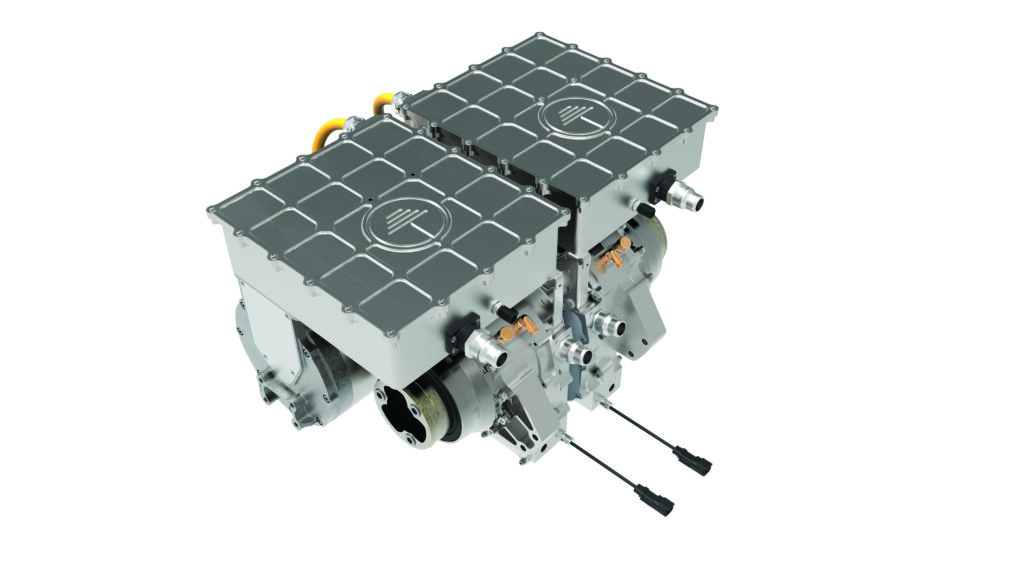E-axles are becoming one of the favored methods for rapid integration of electric powertrains into vehicle platforms and have been deployed across applications ranging from micromobility to trucks and hypercars. Targeting the latter of these markets is the Ampere-220 from UK-based Equipmake. The compact and power-dense e-axle makes 440kW of peak power in an 85kg package incorporating motors, inverters and transmission.
The basis of the Ampere-220 axle is a pair of high power density, 220kW permanent magnet motors constructed using Equipmake’s proprietary spoke motor topology, which according to company founder Ian Foley has been subject to extensive optimization to improve thermal management and cooling.
“One of the big issues if you look at all electric motors, particularly permanent magnet motors, is that they are at similar efficiency. To keep the numbers simple, let’s say 95% efficient. If you have a 200kW motor, that means there is 10kW of heat you need to get out,” explains Foley. “As you make the motor smaller, it becomes more difficult to remove that heat. This means thermal efficiency and thermal management become much more critical. What we’ve done is address that, so we can get a high continuous performance out of a very small motor.”
Thermal strategies
 Foley notes that if you spin a motor twice as fast you can halve the size for a given power output. However, he points out that this means thermal management is further complicated by the reduction in the surface area of key components, such as the rotor.
Foley notes that if you spin a motor twice as fast you can halve the size for a given power output. However, he points out that this means thermal management is further complicated by the reduction in the surface area of key components, such as the rotor.
“If you’re blowing air over it or passing water through it, it’s more difficult to get the heat out. You’ve got half the mass of stuff generating the same amount of heat, and that’s really the limiting factor. For electric motor and power electronics technology, increasing the thermal efficiency will be one of the main areas of development over the next few years,” he says. “Everybody kind of knows how to make a permanent magnet motor spin reasonably fast. Getting the heat out is a different matter.”
Foley is unwilling to delve into too much detail on the specifics of Equipmake’s cooling design, the secret sauce of the motor, but does reveal a little. “We have direct cooling of the stator, combined with internal heat exchange within the motor for rotor cooling.”
This approach presents its own problems, given the temperature delta between the rotor and stator and a requirement for these components to operate at different temperatures. “They are very closely thermally coupled. If you blow air down the middle, you are cooling both. You might not need to cool the stator as much as the rotor, but you can’t help heat from both going into that medium. That’s what makes it very challenging from an engineering point of view and something we’ve tried to address with this motor.”
One tool that Equipmake has made extensive use of in its quest to optimize thermal management is additive manufacturing, specifically for the heat exchangers in the motor. “There are people who can make very effective heat exchangers using additive manufacturing,” says Foley, “so we have looked at how to integrate them into the core motor design.” The design flexibility afforded by additive manufacturing has enabled the company to attain 100% of the potential thermal performance. “We could probably only get 80% of the way there with traditional manufacturing,” he adds.
Loss leader
A further important element of the thermal management and overall efficiency strategy is balancing the copper and iron losses in the motor, because efforts to reduce one often have an effect on the other. Foley explains, “If you have lower losses, that’s less heat to get rid of in the first place.” As the motor size is reduced, so is the amount of copper used. “That means the DC losses go up,” says Foley. “Then, as you spin it faster, the AC losses go up. The key is how you balance that. Sometimes you’re better off having less copper and thus greater DC losses, if that reduces the AC losses.”

This balancing act has been an area of intense research for Equipmake, and Foley is the first to admit that it is still not fully understood. “We’ve got a really good team on motor design and we’re finding out new stuff all the time as we make something, test it, instrument it and feed that data back into our models. It’s a really exciting time. But at the end of the day we’re a business, not a university. So we have to convert that learning into real products.”
Another factor reducing system-level losses in the Ampere-220 is the use of SiC-based power electronics, also developed in-house. “One of the reasons why SiC is becoming more interesting for automotive is that as you spin things faster you get smoother power delivery, and you want a high electrical frequency. But then switching speeds go up and so do your power electronics losses. SiC helps that, but it’s still all a balancing act.”
Foley is adamant that to create a truly efficient overall drive system, integration is key. It’s something that is easier to achieve when engineers have control over all aspects of a design. “It’s only by designing the things together that you can really optimize the system. I think that one of our strengths is that those teams are next to each other in the office, so there’s continual communication. If you have an inverted division or a company over here and a motor company over there, you’re not going to have the same level of integration among those development teams.”
Transmission integration
Foley poses a question: “Where is the balance between how fast you spin the motor and getting that speed to the axle, because for a given application the axle speed is fixed? As the motor gets faster, the gearbox gets bigger, so we have to find the right balance.”
To answer this question, the Ampere-220 relies on a compact, two-stage reduction gearbox. As Foley highlights, its design is somewhat unconventional: “As with the motor and inverter, we’ve taken the step-down gearbox design in-house. It’s a two-stage, single-speed gearbox with a conventional spur gear and an epicyclic gear. That takes us from 30,000rpm to 1,800rpm.”
In its twin-motor form, the e-axle features a pair of these gearboxes, one per motor, enabling the application of torque vectoring strategies. Foley points out that the motor speed was set at what the company feels is the optimum, although this could change in the future. “We’ve ended up with 30,000rpm but there’s no fundamental reason why you couldn’t have a 100,000rpm motor. But then the gearbox is going to get bigger, because as the motor size goes down, the gearbox size goes up. And you get an efficiency loss on each stage you add to the gearbox. So again it is about finding the right balance.”
Production ready
Foley suggests that beyond the use of additive manufacturing, there is little else in the Ampere-220 motor’s make-up that makes it significantly different from other mass-manufactured units, from a production perspective. With this in mind, Equipmake is scaling its production capabilities to a level where it can produce several thousand units per year.
“We have interest from major OEMs,” concludes Foley. “We’ve got the hypercar space covered, which is the tens to hundreds of units, and there’s then another space where a lot of OEMs might produce, say, thousands of a specialist vehicle, something that is not truly a mass-produced solution. That is the next area we are interested in.”



